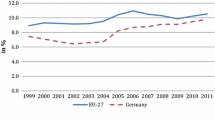Abstract
The paper studies whether temporary jobs in the form of fixed-term replacement contracts reduce the risk of future unemployment among job-seekers. Using matching on detailed information on labour market history and personal characteristics we find positive average effects of having a replacement contract. Our second focus is on whether the duration of the contract matters. We use data on replacement contracts with information on the ex ante duration of the contract which is determined by the individual on leave and find no significant effect on the subsequent unemployment risk of the replacement worker. However, the longer the replacement contract the higher is the probability of having an open ended contract at the same site 2–2.5 years after the start of the contract. Overall, the results suggest that replacement contracts may reduce the risk of future unemployment, but that longer contracts only improve the position within the workplace and not necessarily on the labour market in general.
Similar content being viewed by others
References
Altonji J, Pierret C (2001) Employer learning and statistical discrimination. Q J Econ 116(1): 313–350
Ashenfelter O (1978) Estimating the effect of training programs on earnings. Rev Econ Stat 60: 47–57
Autor D, Houseman S (2005) Do temporary help jobs improve labor market outcomes for low-skilled workers? Evidence from random assignments. Upjohn Institute Staff Working Paper No 05-124
Biewen M, Fitzenberger B, Osikominu A, Waller M (2007) Which program for whom? Evidence on the comparative effectiveness of public sponsored training programs in Germany. ZEW Discussion Paper No 07-042, Mannheim
Booth AL, Dolado JJ, Frank J (2002) Symposium on temporary work: introduction. Econ J 112(480): F181–188
Borland J, Tseng Y (2004) Does ‘Work for the Dole’ work? Melbourne Institute Working Paper No 14/04
Carling K, Larsson L (2005) Does early intervention help the unemployed youth?. Labour Econ 12(3): 301–319
Dehejia R, Wahba S (1999) Causal effects in non-experimental studies: re-evaluating the evaluation of training programs. J Am Stat Assoc 94: 1053–1062
Forslund A, Johansson P, Lindqvist L (2004) Employment subsidies—a fast lane from unemployment to work? Working Paper 2004:18, IFAU
Gerfin M, Lechner M (2002) Microeconometric evaluation of the active labour market policy in Switzerland. Econ J 112(482): 854–893
Heckman J, Ichimura H, Todd P, Smith J (1998) Characterizing selection bias using experimental data. Econometrica 66(5): 1017–1098
Heinrich C, Mueser P, Troske K (2005a) Welfare to temporary work: implications for labor market outcomes. Rev Econ Stat 87(1): 154–173
Heinrich C, Mueser P, Troske K (2005b) The impact of a temporary help job: an analysis of outcomes for participants in three Missouri programs. Mimeo
Holmlund B, Storrie D (2002) Temporary jobs in turbulent times: the Swedish experience. Econ J 112: F245–F269
Hotz J, Imbens G, Mortimer J (1999) Predicting the efficacy of future training programs using past experience. NBER Technical Working Paper, 238
Imbens G (2004) Semiparametric estimation of average treatment effects under exogeneity: a review. Rev Econ Stat 86: 4–29
Ioannides YM, Loury LD (2004) Job information networks, neighborhood effects and inequality. J Econ Lit
Johansson P, Martinson S (2000) The effect of increased employer contacts within a labour market training program. Working Paper 2000:10, IFAU
Katz L, Meyer B (1990) Unemployment insurance, recall expectations and unemployment outcomes. Q J Econ 105(4): 973–1002
Larsson L (2003) Evaluation of Swedish Youth Programs. J Hum Resour 38(4): 891–927
Larsson L, Lindqvist L, Skans ON (2005) Stepping-stones or dead-ends? An analysis of Swedish replacement contracts. Working Paper 2005:18, IFAU
Lindqvist L (2004) Deltagare och arbetsgivare i friårsförsöket. Rapport 2004:6, IFAU
Neal D (1999) The complexity of job mobility among young men. J Labour Econ 17: 237–261
Pellizzari M (2004) Do friends and relatives really help in getting a good job? Discussion Paper 623. CEP, London
Skans ON, Lindqvist L (2005) Causal effects of subsidized career breaks. Working Paper 2005:17, IFAU
Wallette M (2004) Temporary jobs in Sweden. Incidence, exit, and on-the-job training. Lund Economic Studies 120, Lund University, Lund
Zijl M, van den Berg GJ, Heyma A (2004) Stepping stones for the unemployed: the effect of temporary jobs on the duration until regular work. Working Paper 2004:19 IFAU
Author information
Authors and Affiliations
Corresponding author
Rights and permissions
About this article
Cite this article
Hartman, L., Liljeberg, L. & Skans, O.N. Stepping-stones, dead-ends, or both? An analysis of Swedish replacement contracts. Empir Econ 38, 645–668 (2010). https://doi.org/10.1007/s00181-009-0283-9
Received:
Accepted:
Published:
Issue Date:
DOI: https://doi.org/10.1007/s00181-009-0283-9




